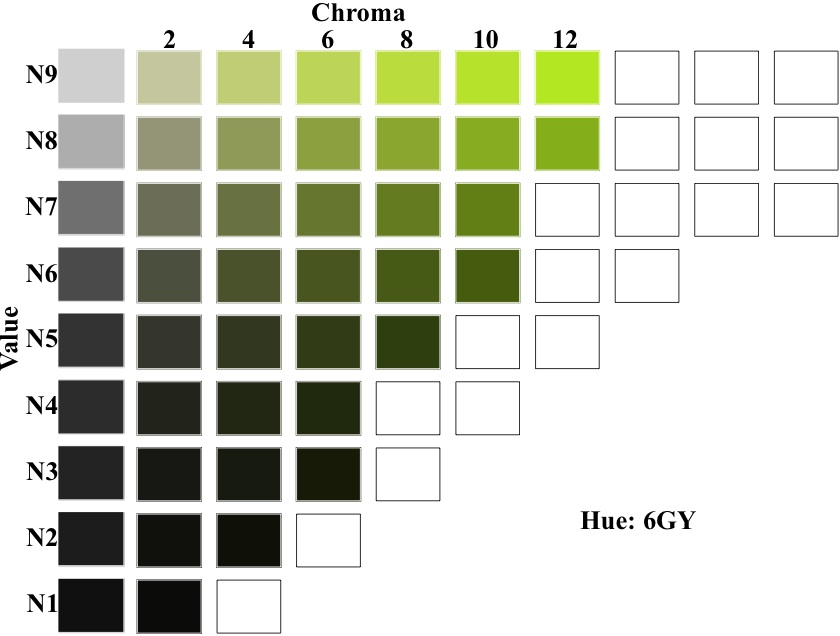
The Munsell colour system is a colour classification and specification system that is tailored for painting and the visual arts. It was developed by the American painter and teacher Albert Munsell, at the start of the 20th century, as an educational tool. Early versions of the system were collections of hand-painted swatches, which were used as physical standards for judging other colours. A major advance was the 1943 Munsell renotation, which superseded previous versions, and is the standard today. The renotation used thousands of visual assessments of paint samples, by 41 human observers, to provide a firm empirical basis for the system. In addition, the renotation specified a set of 2,745 Munsell colours scientifically. A paint swatch can be measured with a spectrophotometer, and its colour can be specified objectively, in terms of three coordinates. Any two swatches with the same three coordinates, even if they are made from different paint mixtures, will have identical colours. By interpolating between the 2,745 specified colours, any surface colour can be located. The Munsell renotation extends to theoretical limits, providing specifications for colours, such as very intense reds, that have never been produced in paints or inks. The scientific specification is important, because it insures that a Munsell notation refers to the same colour for everybody, regardless of time or setting.
Even without understanding the science behind the Munsell system, painters can still use it profitably, because it is based on natural colour perception. The Munsell colour system classifies surface colours by three perceptual attributes that are basic to painting: hue, value and chroma.
Hue is universally understood. It says whether a colour is red, yellow, purple, etc. Munsell
designates 10 basic hues:
|
Many different colours can have the same hue. The figure, for example,
shows the "hue leaf" for 6GY, a set of colours all of which have hue 6GY. The different
colours within a hue leaf are specified further by value and chroma. The empty boxes indicate
colours that are in the Munsell system, but that are beyond the gamut of the process
used to produce the figure.

|
Munsell value designates how light or dark a colour is. The theoretically darkest black has a value of 0, and is denoted N0. The theoretically lightest white has a value of 10, and is denoted N10. N0 and N10 are theoretical ideals, that actual paints approach, but have so far not reached. Most artists' blacks, such as carbon black, are about N1, rather than N0. Similarly, titanium white is just below N10. Between N0 and N10 are 9 progressively lighter greys, denoted N1, N2, and so on up to N9. The spacing between the greys is perceptually equal. All colours have a Munsell value, not just the neutrals. For example, there are light blues and dark blues. A blue with value 8.5 has the same lightness as N8.5.
Munsell chroma refers to how intense, or saturated, a colour is. For example, a lemon is an intense yellow, while masking tape is a dull yellow. A dull colour is closer to a neutral grey than an intense colour. The Munsell system denotes chroma numerically. Greys have chroma 0. A colour with a chroma of 10 is generally perceived as saturated, and it is rare for paints to have chromas greater than about 16. Colours of low chroma, say 4 or less, are perceived as subdued, with a high grey content. It is often difficult to distinguish the hue of low-chroma colours. For example, one cannot say readily whether masking tape is more yellow or more orange. The hue of high-chroma colours, by contrast, can easily be identified.
The Munsell notation for a colour takes the form
| H V/C, |
The Munsell system is important to painters for several reasons. First, the attributes it
identifies (hue, value, and chroma) are all vital to art. A painter should see his paintings
in those terms. Value is the most important. A black and white reproduction of an image
retains the Munsell values, but discards all hues and chromas, yet there is no trouble "reading" the
black and white reproduction. A painter should similarly learn to look at paintings solely in
terms of lights and darks. Classically, a tonal underpainting served to make sure the light
and dark structure was sound. Chroma is also important. Colours whose chromas are too high
(in the context of a painting) tend to be "loud" and jarring, calling undue attention to
themselves. Colours whose chromas are too low will not provide sufficient emphasis. Secondly,
the Munsell system provides a way to communicate about colour. Even if they are on different
continents, two painters can be sure they are talking about the same thing when they discuss,
for example, the relationships between value and chroma in shadow colours. Thirdly, the Munsell
system suggests simple yet flexible procedures, such as the Reilly method for mixing paints, that a
painter can easily control.